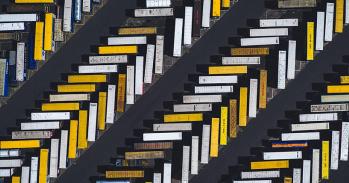
Cambridge University study charts the symbolic resistance of the Channel Islanders during the occupation of World War II.
Cambridge University study charts the symbolic resistance of the Channel Islanders during the occupation of World War II.
The story is not only about what they made, but why they were making it."
Dr Gilly Carr
They were left undefended by the British, conquered by the Germans and then taken to the brink of starvation as the Allies fought their way through the rest of Europe following the D-Day landings.
Now, more than 60 years after their liberation in May 1945, new information about how the people of the Channel Islands quietly defied their Nazi occupiers is being brought to light by a Cambridge University archaeologist.
Dr Gilly Carr is carrying out the first ever full study of the artwork, tools, trinkets and other artefacts made by both the islanders and their German occupiers during World War II. Her work is uncovering fascinating new stories about the quiet resistance displayed by those who were deported to German prison camps, and by the friends and family they left behind.
The Channel Islands were the only part of Britain occupied by the Germans during the war. Two thousand locals were deported in total in 1942 and 1943, when Hitler ordered that those who had not been born on the islands were to be taken to civilian internment camps in Germany.
Those who stayed endured siege conditions after June 1944 when the Allies bypassed the islands and landed in Normandy. With their supply lines cut off, islanders and occupiers alike had to survive for almost a year with dwindling food and fuel reserves, and although the Red Cross was eventually allowed to deliver supplies from December 1944, many were severely malnourished by the time they were liberated at the war's end.
Dr Carr, whose own family are Channel Islanders, is the first scholar to fully investigate the artefacts of the occupation - inspired by the stories of relatives and friends. Using both public and private collections, she is piecing together a detailed picture of how the islanders of the 1940s quietly refused to acknowledge German rule.
Surrounded by a high density of soldiers, the locals could only really put up symbolic resistance. What the materials now being studied by Dr Carr show is the extent to which they managed to do so. The physical archive features dozens of examples of V for Victory badges that were manufactured from coins, and worn secretly under the lapels of their jackets. In the internment camps, the V symbol was used wherever possible, often covertly. One woman even stitched a dedication to George "V" into her tablecloth, her German occupiers apparently oblivious to the fact that George VI was on the throne at the time.
Radios, used to tune in to broadcasts from the BBC on the mainland, were also widespread, but hidden to avoid them being confiscated during spot searches by the Germans. Dr Carr has found examples of small radio sets that were concealed in books, biscuit tins and even light switches.
Her research has also shown how a symbolic "war" was fought between the islanders and the Germans over the use of the Channel Islands crest. The symbol, of three lions passant guardant, was appropriated by the occupying force on arrival and incorporated, along with Germanic symbols, into the artwork they produced during their stay. But the islanders fought back, producing their own artefacts that used the crest in less visible contexts, often incorporated into jewellery.
"The importance of these artefacts is in what they tell us about the experience of war," Dr Carr says. "The story is not only about what they made, but why they were making it. For the islanders, unable to mount a proper resistance movement, making the King's head and the crest into jewellery was often the only way they really had of fighting back against the appropriation of their islands and symbols by the Germans."
Those Channel Islanders who were deported to Germany were no less defiant. Objects recovered from the prison camps where they were interred at Biberach an der Riss, Wurzach, Liebenau and Laufen, include sandals made from parcel string, paintings, trinket boxes made from Red Cross tins, and several mugs that were beautifully engraved with camp scenes by one islander, Byll Balcombe. These were presented to fellow detainees to mark anniversaries, weddings and birthdays, but were also dotted with patriotic references - including a map of Guernsey and a reference to Blighty spelt "Bhliti", so as not to be spotted.
Others used any supplies they could find, or even barbed wire, to make badges showing solidarity, or in the shape of the Union flag. Perhaps most audaciously of all, a picture recovered from the time shows how one deported islander, Monty Manning, shaved his beard into a "V" and paraded about the camp without the reference ever apparently being picked up by his German guards.
As well as describing their quiet non-compliance with German rule, many of the items Dr Carr has studied show how the islanders did whatever they could to make life under the Germans tolerable. The artefacts showing this include a version of Monopoly called "Occupation", which features instructions like "Ration of jam, go forward 2" and "exceeded electricity ration, go back 5". In the camps, where the prisoners ran schools for their children, set up a theatre and organised evening classes to alleviate their boredom, they also created a chess set from wooden crates, crocheted the cellophane in which supplies were packaged, and even in one case re-embroidered the same pillow case 12 times to save themselves from going mad with boredom.
"These items show how the Red Cross parcels not only saved their lives in terms of feeding them, but also in terms of keeping up morale and rescuing them from the boredom of the occupation," Dr Carr said.
"A lot of it tells us about the mental state of the people who were living under occupation. They didn't know when the war was going to end, whether they were going to be in this situation for the rest of their lives, or whether they might ultimately be sent to concentration camps. The emphasis was really on making life as bearable as they possibly could."
This work is licensed under a Creative Commons Licence. If you use this content on your site please link back to this page.





